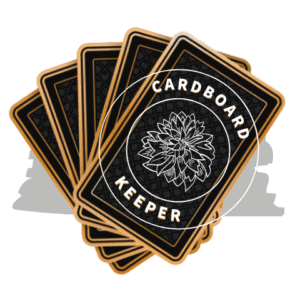Some of the most famous MTG equipment cards have been format-defining throughout the history of Magic The Gathering. These powerful and popular equipment cards in Magic have gone on to have entire decks built around them or warped formats to the point where the card has needed to be banned.
Whenever you are building a deck, especially a commander deck, it doesn’t hurt to take a moment and see if you can make room in your deck for some of these powerful equipment cards.
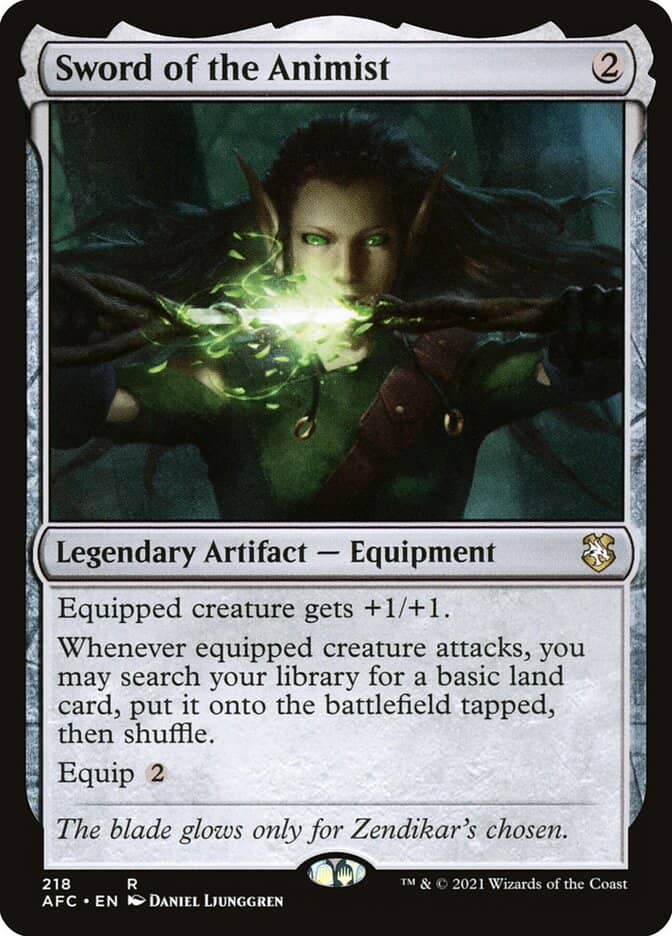
1. Sword of the Animist
Recommended Format: Commander
Sword of the Animist is a great way to ramp up your nana pool in long MTG games.
For 2 mana, and a 2 equip cost, you can search your deck for a basic land and put it straight on the battlefield tapped. This doesn’t count as your land per turn either, so you can quickly build up your lands.
This is a great addition to green decks since mana-ramping is a huge part of many decks. While it generally can’t get out until turn 4, other early, mana-ramping cards in green decks can bring this card out much earlier.
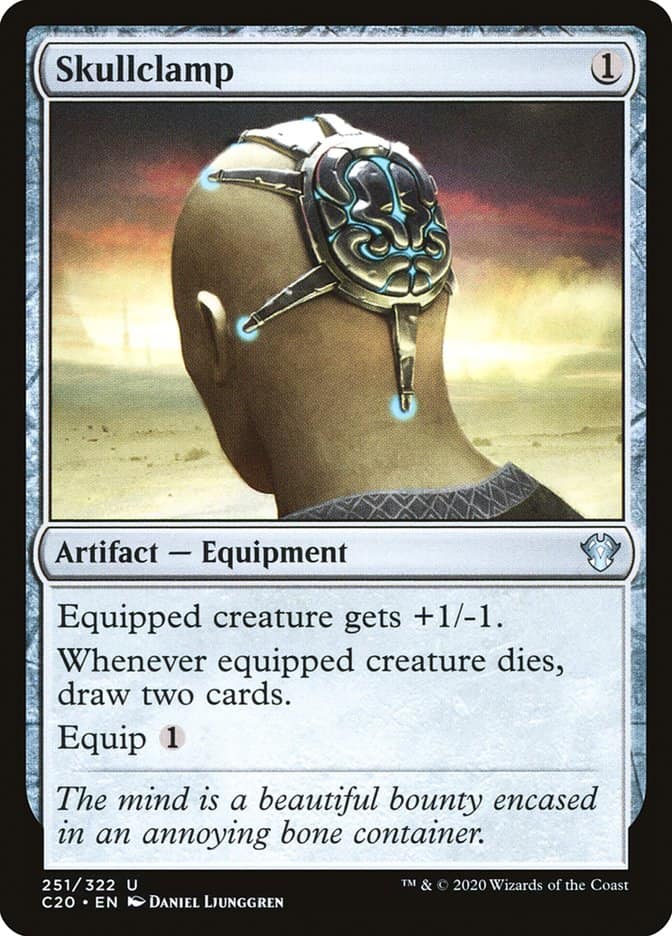
2. Skullclamp
Recommended Format: Commander
Skullclamp is one of the most interesting equipment cards to see play in MTG and one of the few equipment in Magic’s history that have been banned.
For 1 mana and a 1 equip cost, Skullclamp could give a creature +1/-1. If the equipped creature died, then you could draw two cards.
At first glance, it doesn’t look like anything too impressive. However, it’s a very cheap and easy way to get rid of enemy 1/1 creatures – which happens to apply to most decks running tokens, a pretty common mechanic in the game.
It can also be used back-to-back in a turn, so you can get rid of as many creatures with 1 health as long as you have the mana. In long formats, like Commander, this is pretty ideal.
Because of this, it was used a bit in pro play during 2004 when it was in Block rotation (a previous MTG format that was similar to Standard.)
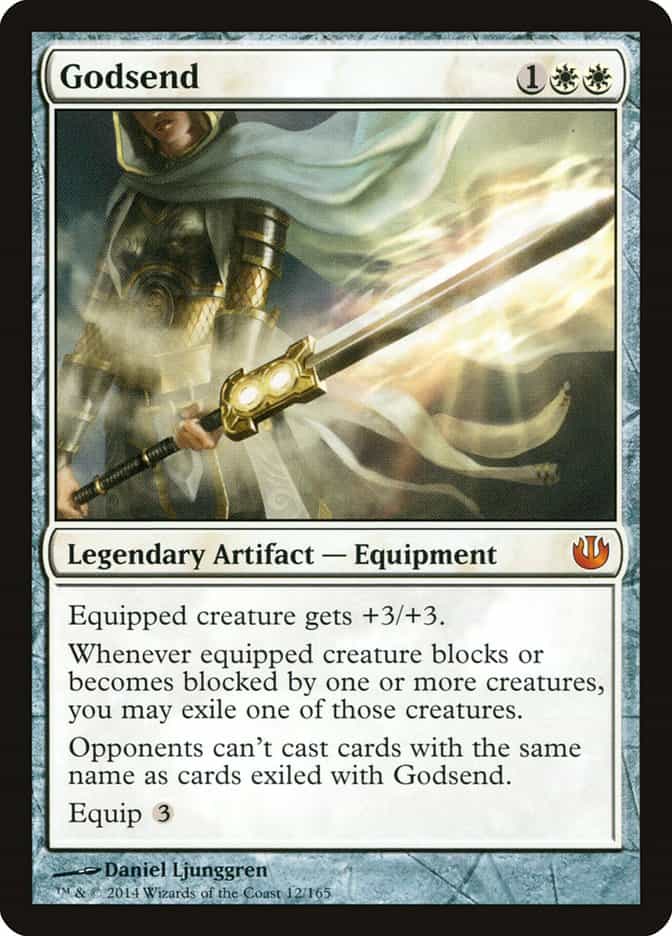
3. Godsend
Recommended Format: Commander
Sometimes you have to weigh your options before swinging in during combat — your opponent blocking your creatures with more powerful creatures can make it a tough decision.
If you have Godsend attached to your creature, then you don’t have to worry about this.
For 3 mana and an equip cost of 3, Godsend makes it so that anytime the equipped creature is blocked, you can exile the creature blocking it (or pick one when the equipped creature is being blocked by multiple creatures.)
Additionally, your opponent can’t play cards with the same name. If your opponent doesn’t have a way to deal with your creature, then Godsend can very easily be a way to end the game in just a few turns.
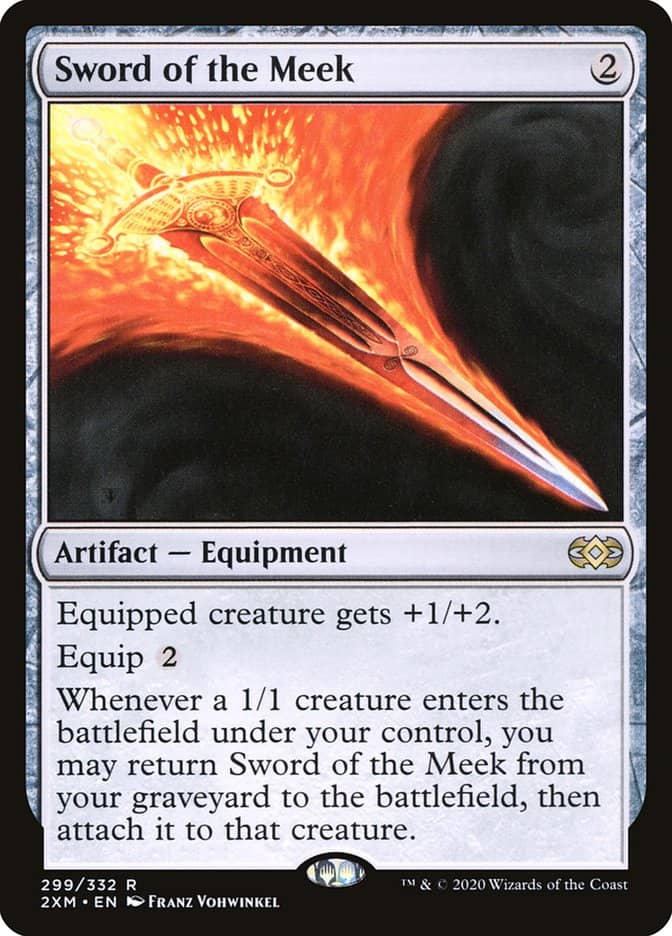
4. Sword of the Meek
Recommended Formats: Commander, Modern
Sword of the Meek is a 2 drop equipment that takes 2 mana to equip.
However, the card allows itself to come back from the graveyard and instantly attach to a creature anytime a 1/1 token is created. This means that Sword of the Meek will almost constantly be in battle if your deck centers around token creation, which is again a pretty common mechanic in MTG.
While it won’t make your creature start swinging for massive amounts of damage, the consistent presence of it can be annoying. The only way to get rid of the card is to exile it, which isn’t always an option.
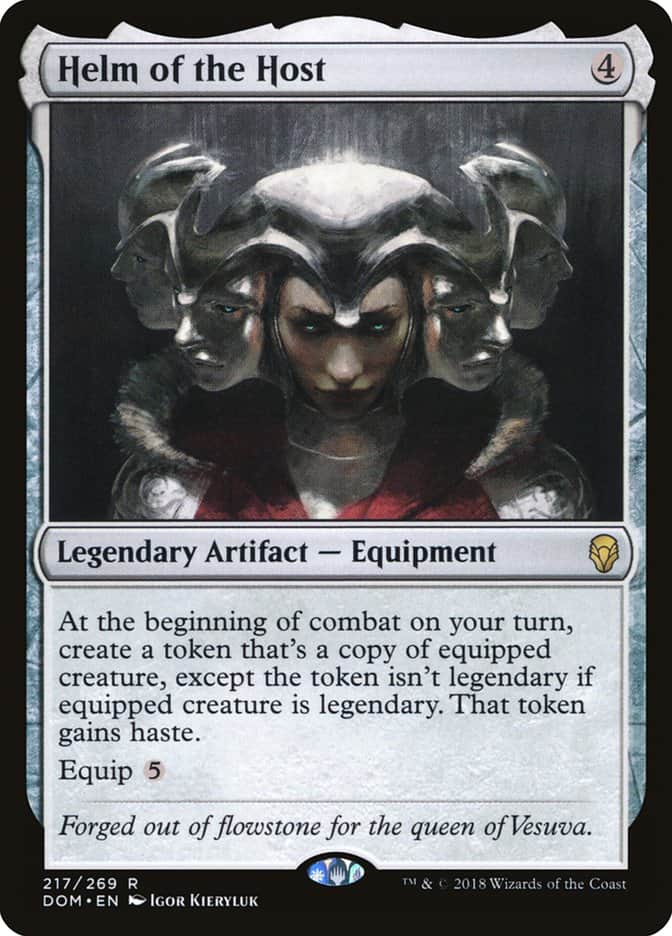
5. Helm of the Host
Recommended Format: Commander
Have you ever loved a creature so much that you want more and more of it?
Helm of the Host does just that, giving you a copy of the equipped creature at the beginning of every combat phase. The copy even has haste, so it can attack. If the creature Helm is attached to is a legendary creature (which would mean that there could only be one on the field), then the copy loses its legendary status so multiple copies can be on the field.
Considering this can happen on every one of your combat turns, you’ll keep spawning creatures until your opponent can either get rid of Helm or the original creature. And, if they get rid of the creature, then you can just attach Helm to the copy of the original creature and keep going.
Not only does the card offer a lot to you, but it’s also incredibly annoying to deal with to your opponent – especially if your deck specializes in hard-hitting creatures.
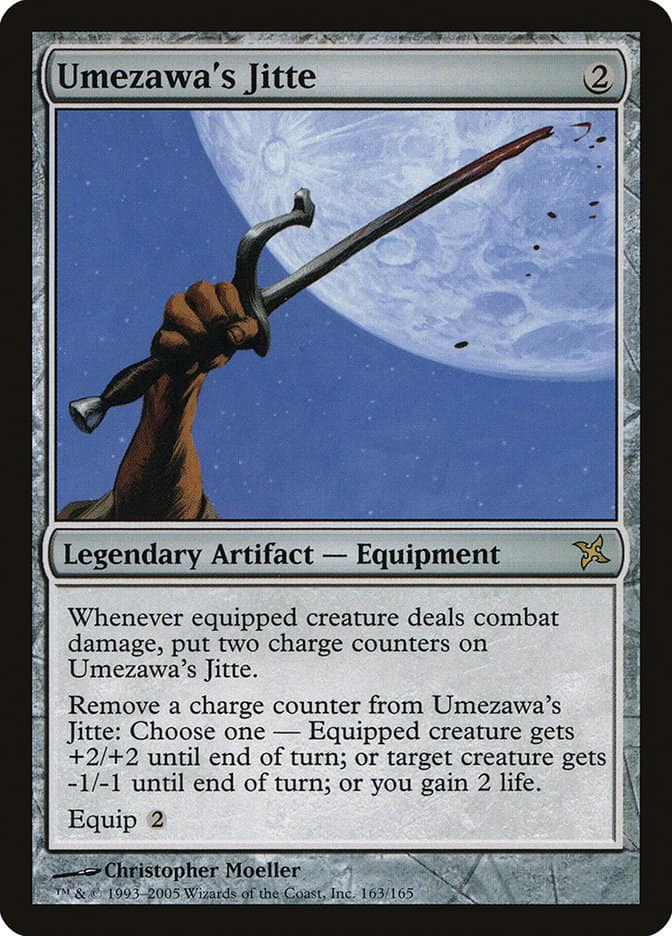
6. Umezawa’s Jitte
Recommended Formats: Legacy, Commander
Umezawa’s Jitte is meant for creatures that your opponent just can’t block, whether that’s because it has flying, menace, or some other equipment or enchantment to help.
At that point, Umezawa’s Jitte can start working. Whenever the equipped creature deals damage to your opponent, then Umezawa’s Jitte gets 2 counters.
You can remove a counter and do one of three things: either give the equipped creature +2/+2, give a target creature -1/-1, or gain 2 life. You can remove these at any time in the game, and you can even use multiple per turn. This can save you with health, ensure a win with extra damage, or even get rid of a nasty creature.
That much utility is hard to ignore, and it’s been used quite often in pro Legacy and Standard decks – in fact, the card’s been seen 10 times in the top 5 decks of tournaments since 2005.
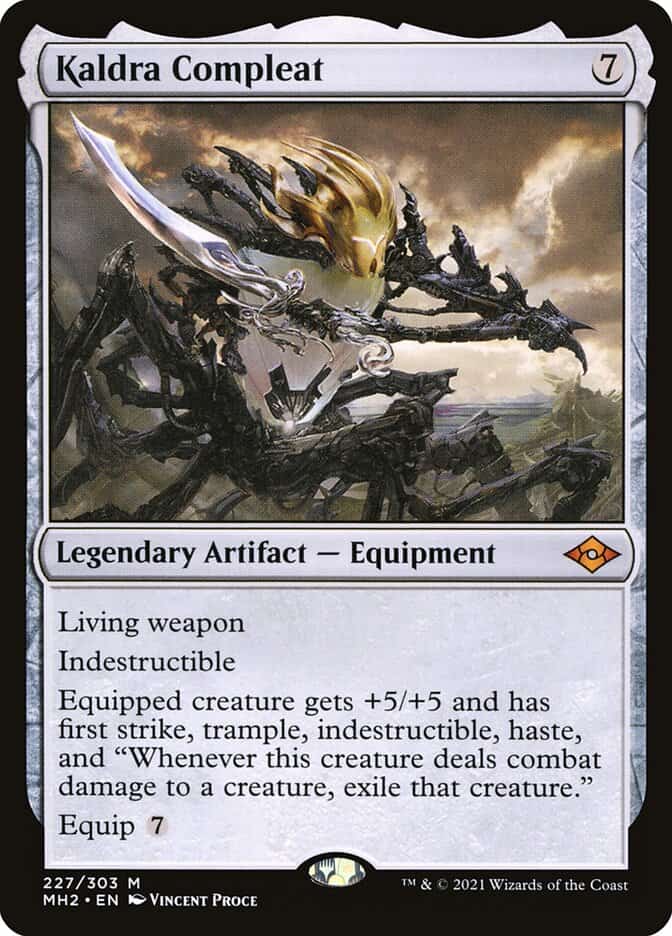
7. Kaldra Compleat
Recommended Formats: Legacy, Commander, Modern
While Kaldra Compleat has a significant converted mana cost and equip cost, both 7, the card is a game-changer.
The equipped creature gets +5/+5 and a plethora of over benefits: first strike, trample, indestructible, and haste. Additionally, any creature that’s dealt damage by the equipped creature (so any blocking creature or any creature that’s blocked by your creature) is exiled.
If that sounds busted, it is. The price for getting Kaldra Compleat out and onto a creature is pretty high, but it’s definitely doable in a longer format such as Commander. If you pull it off, then you’ve got an almost sure path to victory.
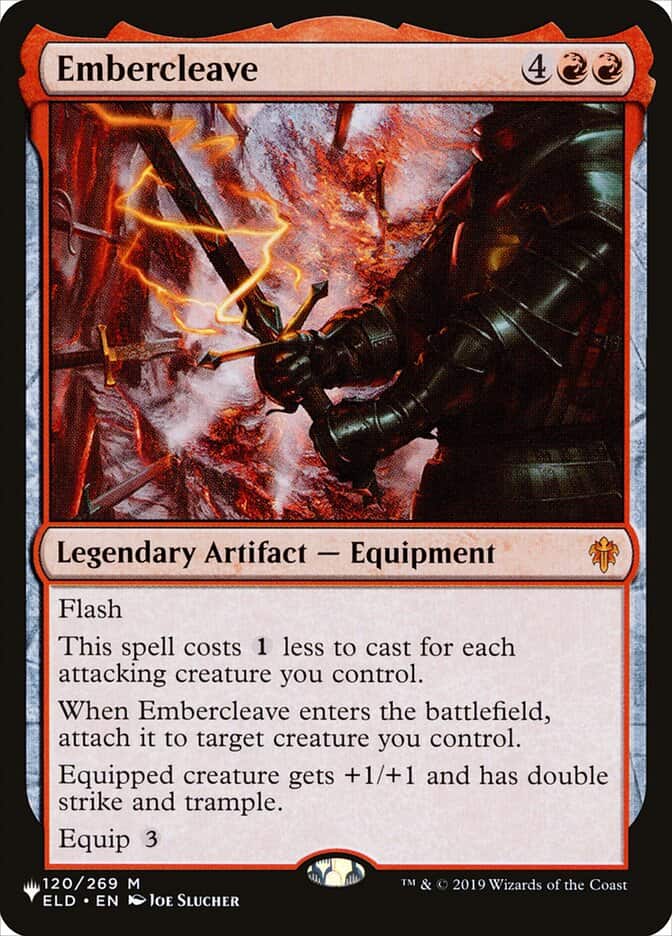
8. Embercleave
Recommended Format: Commander
Taking your opponent by surprise is always fun, and Embercleave lets you do that right in the middle of your attacking phase.
The 6 drop equipment cost 1 mana less for every attacking creature you have, making it perfect to use after you’ve declared your attackers (and even better if your opponent has already declared blockers.)
When you first cast Embercleave, it’ll go straight onto a creature like an enchantment does. That creature will get +1/+1 and double strike and trample, which means that you can double a creature’s damage or force some damage to go through if the creature was blocked.
The card was released in 2022 and hasn’t seen a bunch of play because it’s one of the newest cards on this list.
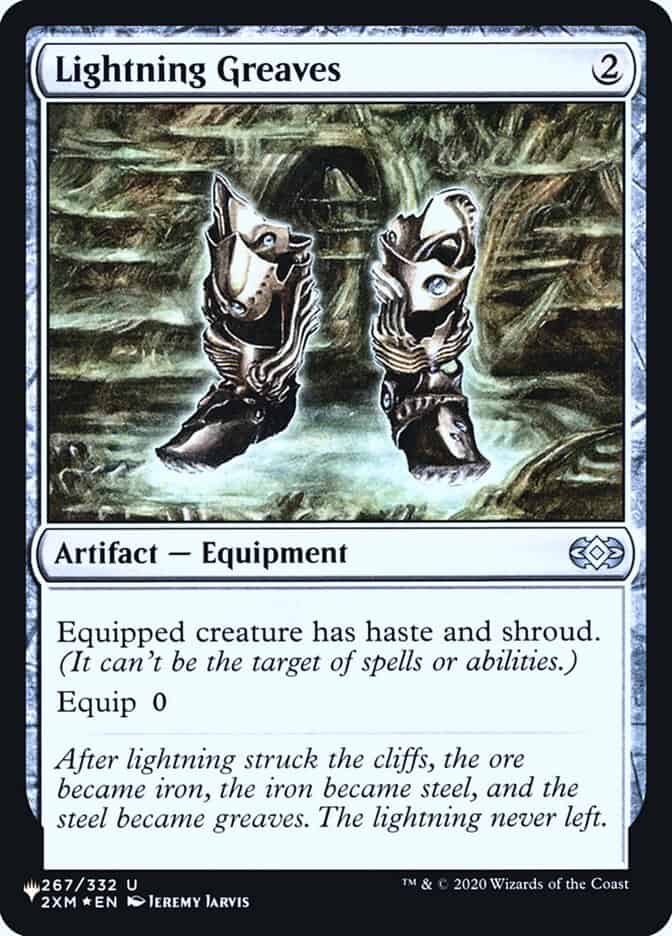
9. Lightning Greaves
Recommended Format: Commander
Sometimes the key to winning is giving your creature hexproof or another way to stay alive against your opponent’s removal cards.
Lightning Greaves is a way to do that for only 2 mana with a 0 equip cost. The card gives your creature shroud, which basically means that the creature can’t be targeted by any spells, including your own.
While not being able to target your creature with useful spells sounds bad, it’s easy to get around considering Lightning Greaves has a 0 equip cost – you can easily move the equipment off and on the creature on your turn to target the creature.
As if that’s not enough, Lightning Greaves also gives creatures haste, so it has multiple uses for only 2 mana.
It was part of a deck that won first place in a pro tournament back in 2003, back when Extended was an official format (Extended was basically Standard except for the fact that sets would stay in rotation for longer.)
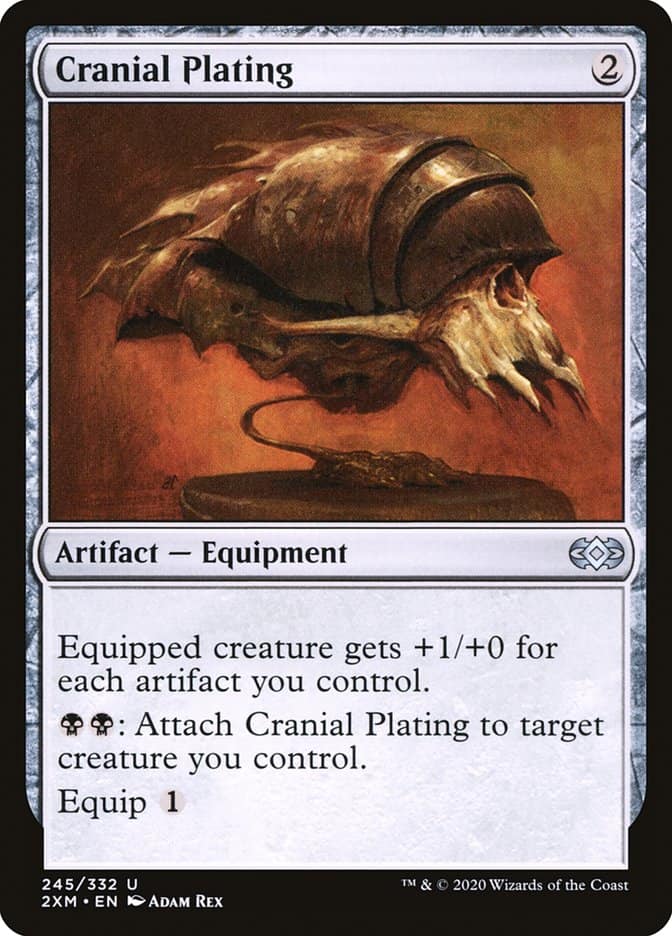
10. Cranial Plating
Recommended Formats: Penny Dreadful, Commander, Modern
If you’re playing an artifact deck, then Cranial Plating is a must-have.
The 2 mana card gives the equipped creature +1/+0 for every artifact that you control, and it’s got two ways to be equipped. The first way costs 1 mana and can be used in the same way any equip works. However, its 2 mana ability allows you to equip the card at instant speed, just like any other card’s ability can be used.
This makes for some pretty crazy combos – if your opponent isn’t paying attention, then you can use this to block and kill an attacking creature or ramp up your own creature that’s not being blocked. Because of this, Cranial Plating dominated pro play back in 2004, showing up in multiple first-place decks.
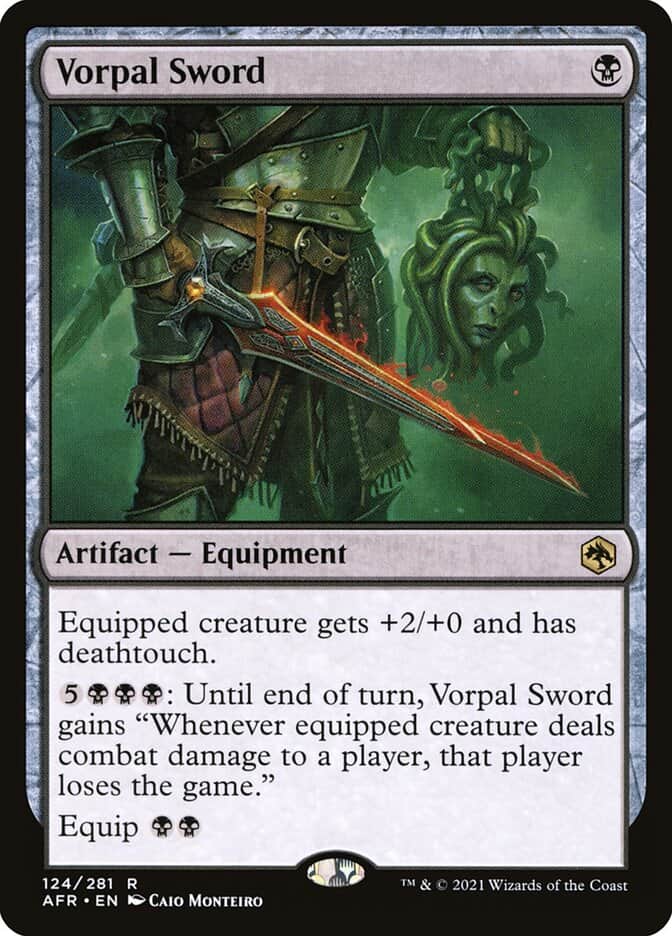
11. Vorpal Sword
Recommended Format: Commander
For 1 mana and an equip cost of 2, Vorpal Sword can give a creature +2 attack and deathtouch, making any creature a great blocker to any massive enemy. When used as a way to remove creatures, it’s pretty decent.
However, Vorpal Sword shines with its 7 mana ability. If the equipped creature deals damage to your opponent, then you automatically win the game.
Considering there are plenty of different cards that can make a creature unblockable, then you can force a win with this. It does take quite a bit of mana to set up, but it’s easy enough to do in Commander since the games generally run longer.
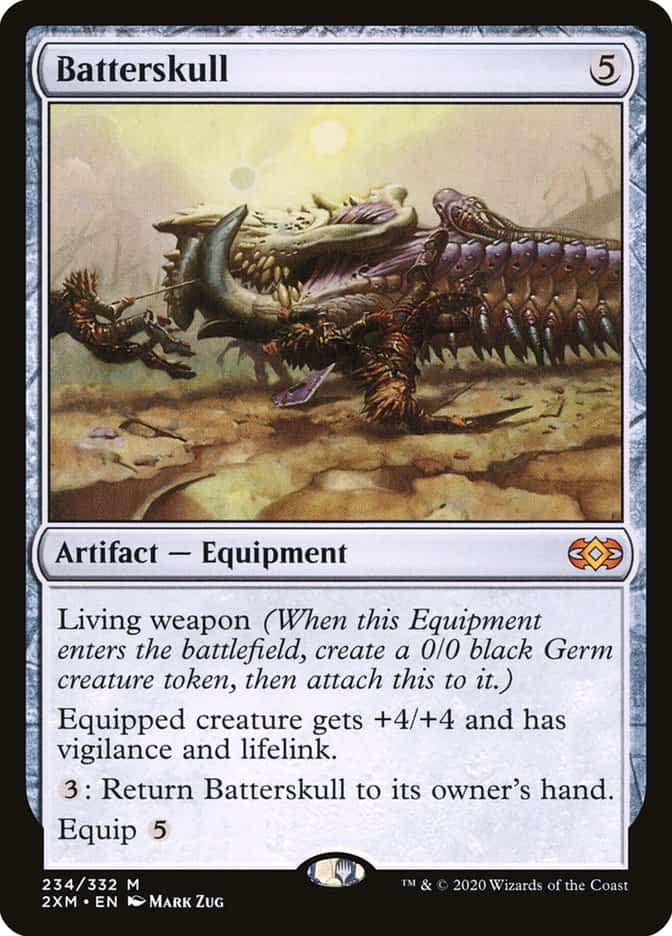
12. Batterskull
Recommended Formats: Legacy, Modern, Commander
Batterskull is an interesting and effective artifact that can leave your enemy at a loss for what to do. For 5 mana, you can play Batterskull and basically create a 4/4 creature token with vigilance and lifelink that Batterskull’s attached to.
From there, you can bring Battleskull back to your hand for 3 mana at instant speed, making it almost impossible for your opponent to deal with unless they have a way to remove cards from your hand.
The card’s been seen a couple of times in pro Modern and Legacy tournaments, and it was used a bit when it was Standard legal back in 2012.
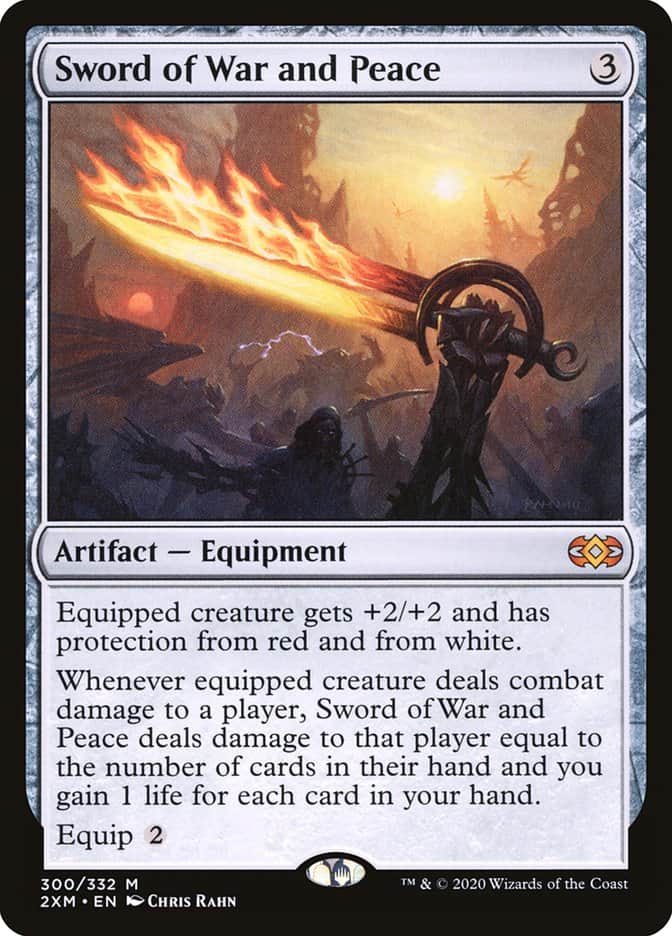
13. Sword of War and Peace
Recommended Format: Modern, Commander
Sword of War and Peace is a pretty powerful piece of equipment that’s always good but has the potential to be oppressive.
For 3 mana and 2 mana to equip, Sword of War and Peace gives your creature +2/+2. It also has a passive that deals extra damage to your opponent based on the number of cards in their hand while also healing you based on the cards in your hand anytime the equipped creature deals damage to your opponent.
While that’s great and all, Sword of War and Peace also protects the creature from red and white. Depending on the deck your opponent is using, this can be a massive advantage. White is known for enchanting creatures to stop them from dealing damage, and red spells can quickly target and take out creatures. Having protection from those two colors can cause quite a bit of problems for any opponent running those colors.
Because of this, the card was seen quite often in pro play when it was in Standard, and it was in a winning Block deck back in 2011 (Block has since been discontinued as a format since Wizards of the Coast releases cards in full sets and not blocks anymore.)
There were actually seven versions of this card with different names that had protections from different colors – Sword of War and Peace is one of the most effective in the set, which all followed the naming conventions of “Sword of [blank] and [blank].”
